Culture is a hot topic in the Lean community. I just searched Google for “lean” “culture”: about 111.000.000 results (0,32 seconds)! I obviously did not read them all but over the years I got the impression that most of what I read is missing the point.
As I wrote before, I think the cultural part of Lean really is the missing link. In my quest for a better understanding I like to go back to basics and back to the source so I started digging deeper in Toyota’s Culture and did quite a bit of research on The Toyota Way 2001.
Only recently I started to look at Toyota’s culture from a Spiral Dynamics perspective. That is when pennies started to drop!
Toyota’s culture from a Spiral Dynamics perspective
Toyota is a huge organisation with many different practices. I took a selection of these practices and tried to fit them in the Spiral Dynamics framework. This is what I got:
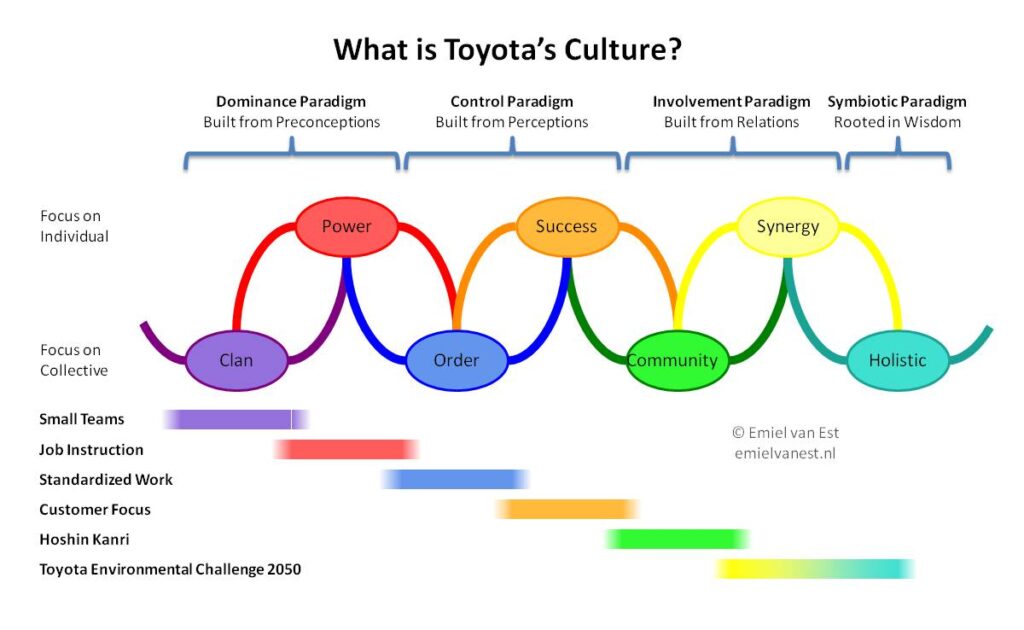
Small Teams
It is well known that teams at Toyota are quite small. Typically a team consists of 5-8 team members, way less than in most “lean” and flat organisations. Why is that important?
Well, have a look at the pictures below. Where would you be more comfortable to speak up?

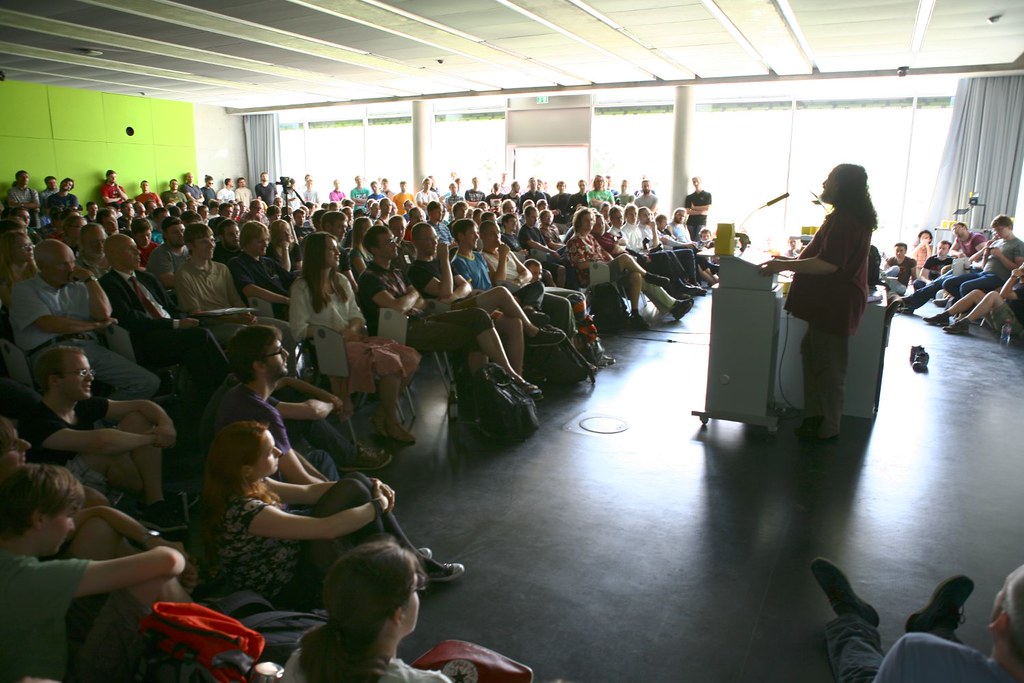
If you are like most people you are way more comfortable to speak up in a small team than in a big team. Small teams have a lot to do with psychological safety.
“Psychological safety was far and away the most important of the five dynamics we found” for the performance of teams, Julia Rozovsky, analyst at Google People Operations wrote in November 17, 2015.
PURPLE Clan
I associate small teams with the PURPLE Clan culture of Spiral Dynamics. It is the culture where safety is the primary concern. Some refer to this culture as The Livingroom. I think that is exactly one of the core purposes of small teams: to feel at home.
Job Instruction
Once you get hired by Toyota to build cars you do not go straight to the assembly line. First you get some rigorous training.
The work is broken down in smaller elements and the instructor shows you how to perform these work elements and points out the important details. After that you get the chance to practice this and to get feedback from the instructor, one job element at a time.
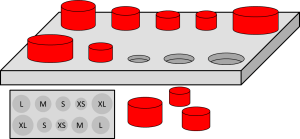
Often this training does not even involve real car parts or real assembly tools. Some of the training material is specifically designed to build muscle memory for certain skills. See Christoph Roser’s post for more information on this subject.
RED Power
I associate Job Instruction with the RED Power culture of Spiral Dynamics.
The RED Power culture is very often associated with the cruel, unreasonable, or arbitrary use of power or control. But there is also another, friendlier, kind of RED where a senior instructor takes the lead to teach you the skills you need to be able to perform your future duties.
It is still a situation where you better listen to your instructor and do as told!
Maybe that is the Toyota twist to RED: the boss is not bossy, the boss is instructing, teaching, helping you to succeed.
Standardized Work
On the website of the Lean Enterprise Institute you can read:
Standardized Work is one of the most powerful [..] Lean tools. By documenting the current best practice, standardized work forms the baseline for Kaizen or Continuous Improvement.
Standardizing the work adds discipline to the culture, an element that is frequently neglected but essential for Lean to take root.
BLUE Order
Standardized Work and discipline, that sounds a lot like BLUE Order in Spiral Dynamics to me. Standardized Work is clearly a subject that fits the Control Paradigm where the perception of facts rules.
Order and Standards may seem rigid. Maybe that is another Toyota twist: to build in the discipline to actually follow the best known way AND to continuously, orderly, and yeah, even disciplined seek improvement.
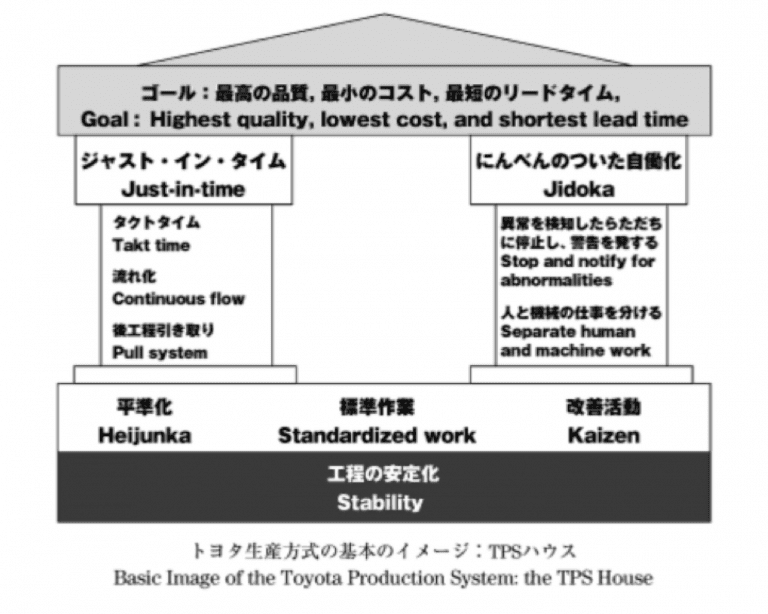
Customer Focus
If you look at the Basic Image of the Toyota Production System you see:
Goal:
Highest Quality,
Lowest Cost and
Shortest Lead Time
These are clearly things that are very pleasing to customers. Toyota is known to go out of its way to make ever better cars for their customers.
ORANGE Succes
A strong Customer Focus is clearly a good thing for all companies that want to be successful. I think this clearly fits the ORANGE Succes culture in Spiral Dynamics.
Hoshin Kanri
Hoshin Kanri, or Strategy Deployment, is a critical element of Toyota’s success. It is a way to break down strategic objectives from the top floor to the actionable steps at the shop floor, to align all the people and all the activities in the organisation.
It is not top down and it is not bottom up. It is a bit of both. Hoshin Kanri is a process that facilitates dialog, known as catch ball, among the different layers and parts of the organisation. The overall goals are firm but the way how to achieve them is open for discussion.
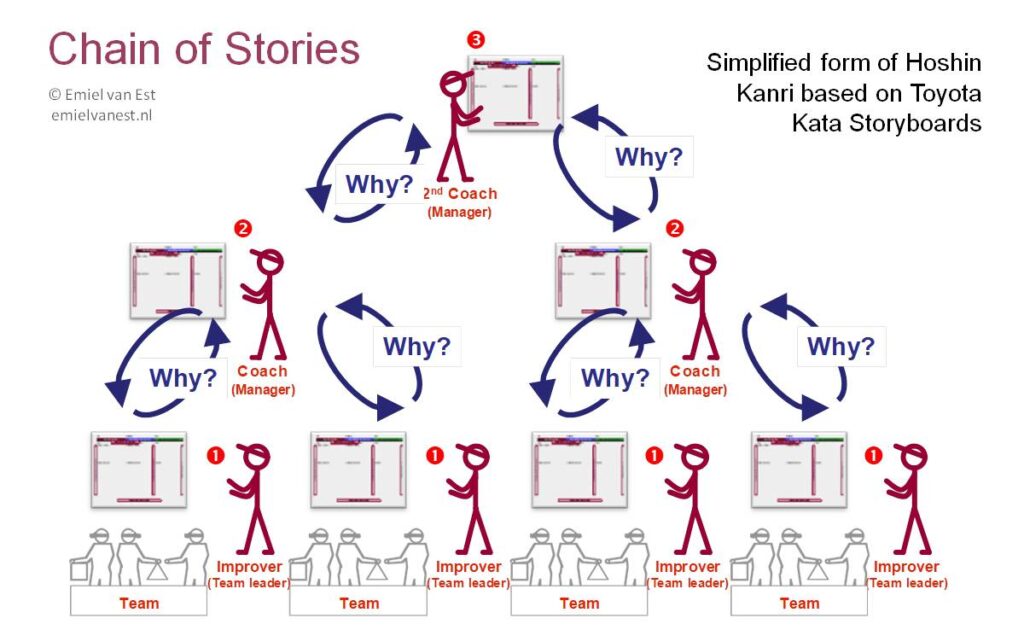
As the saying goes: there are a lot of roads that lead to Rome. Hoshin Kanri is a way to find the most suitable road to Rome given the current condition of the organisation.
Hoshin Kanri builds a chain of congruent stories in the organisation. It facilitates the right dialog among the right people at the right time.
GREEN Community
I think Hoshin Kanri is an example of a practice within Toyota that fits the GREEN Community culture of Spiral Dynamics. It aims to involve all, synchronize action and build the required relations to succeed.
Toyota Environmental Challenge 2050
In 2015 Toyota announced the Toyota Environmental Challenge 2050:
Going Beyond Zero Environmental Impact and Achieving a Net Positive Impact
To achieve this overall challenge Toyota shows the use of Hoshin Kanri by defining six sub challenges in two categories.
Zero CO2
- New Vehicle Zero CO2 Emissions Challenge
- Life Cycle Zero CO2 Emissions Challenge
- Plant Zero CO2 Emissions Challenge
Society in harmony with nature
- Challenge of Minimizing and Optimizing Water Usage
- Challenge of Establishing a Recycling-based Society and Systems
- Challenge of Establishing a Future Society in Harmony with Nature

YELLOW Synergy & TURQUOISE Holistic
I think that the Toyota Environmental Challenge 2050 has many elements from the YELLOW Synergy culture from Spiral Dynamics. All these challenges require Toyota to rally people in many different networks, build very good relations and work together with courage and creativity to achieve these challenges.
I also think that the Toyota Environmental Challenge 2050 has many elements from the TURQUOISE Holistic culture from Spiral Dynamics. The second category of challenges says it all:
Society in Harmony with Nature.
There is another Holistic aspect that deserves attention. The Toyota Environmental Challenge 2050 was announced in 2015. The challenge announced was 35 years into the future! How long do you think Toyota’s 2015 senior leaders will stay Toyota’s senior leaders?
The achievement of the Toyota Environmental Challenge 2050 will be beyond the tenure of most, if not all, of the current senior leaders. Also leadership will have to operate in Harmony with Nature. Current leaders will have to nurture the future leaders to be able to accomplish this challenge. Just think a moment about the implications!
Conclusion
Above I built a case that you can find just about all developmental stages of Spiral Dynamics within Toyota. And that makes total sense if you take developing people seriously.
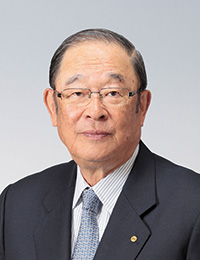
First we build people.
Then we build Cars.
Fujio Cho,
Chairman of the Board and Representative Director of Toyota Motor Corporation from June 2006 to June 2013.
So, what about Lean Culture?
Maybe there is no such thing as a Lean Culture. Maybe Lean needs all the culture and people development stages of Spiral Dynamics. Just as Toyota.
Maybe, over the past 30 years or so, we have been too focused on some arbitrary details of culture and its associated behavior. It is not a simple list of do’s and don’ts. It is way more complicated.
The most complicated thing may be that, for people to develop through the stages of the spiral in a healthy way, the environment needs to be healthy. It is the leaders primary responsibility to create this healthy environment. Therefore, leaders themselves need to be ahead in their development so they can create this environment and help the people they lead to develop as well.
Unfortunately, in most organisations there is a huge gap between current leadership and the leadership that is required for the development of a healthy culture in general and a healthy Lean Culture in particularly.
Change the conversation
The implications of what I try to convey here are huge…
We really need to change the conversation. The traditional Lean training and all the belt training will not move us forward. Current consulting practices will not move us forward. Even many of the current business practices will not move us forward.
We need something new. What exactly? I do not exactly know yet. But once we start a new conversation, build new understanding, design new experiments, evaluate new learnings, we may find a new way forward.
Maybe the image below is a good conversation starter. What do you think?
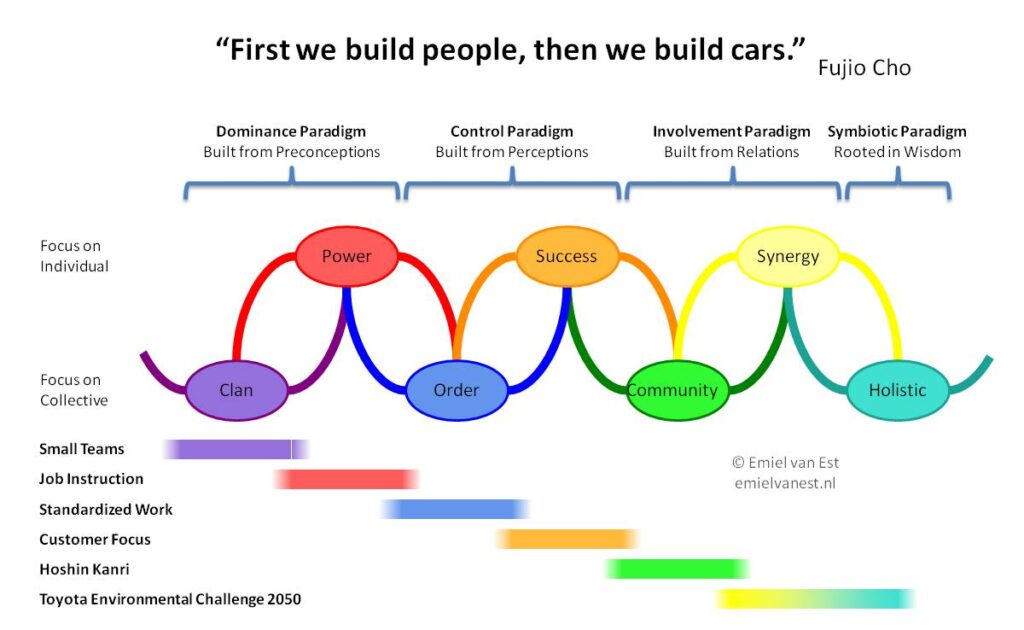
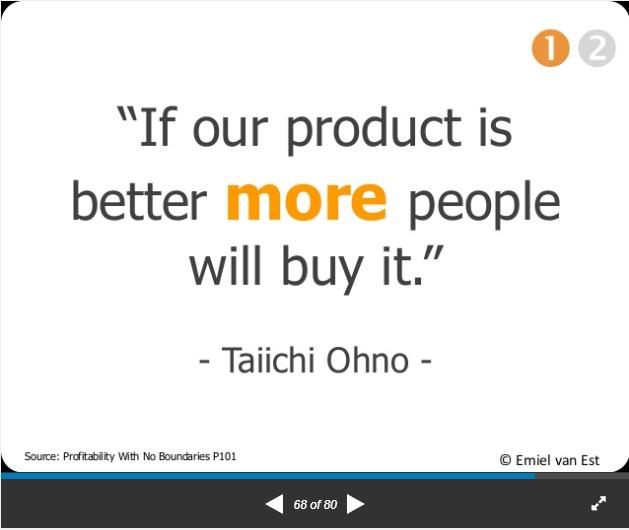
john mortimer says
We certainly need something new… That is proven by the amount of effort we all spend attempting to transform, compared to the true sustained change that actually occurs.
In my experience the evidence demonstrates that transformation has to be about the whole system; everything is included, but starting with the leaders/ senior managers as it is the leaders thinking that create the organisation as a system. And in my experience of many (failures) learning opportunities, it is clear that each leader:
1. Has to go on their own journey of learning & transformation. It is their path and that path may well be very different to someone else.
2. It is their journey, and I can help them, but it is theirs, and my role is to support that.
3. Each leader I come across is different to the next. And the descriptions from Spiral Dynamics is very close to what I have witnessed.
4. Each leader can only go so far along their journey that they decide.
5. This journey is about self discovery, learning, and giving up elements that they have previously seen as being part of themselves.
Your link with Spiral Dynamics and your diagram of operational modes is very interesting when seen in relation to the list above. It also reflects the journey that Taiichi Ono, and Toyota went through, where they spend decades moving TPS forward in both locations within the plant, and in depth.
emiel says
Thank you for your comment John!
I think your points about leaders make sense. Unfortunately, this perspective does not get us in the drivers seat. All is dependent on the willingness of the leader. That is why I think we need to change the conversation. You may find some starting questions in The Leadership Gap.
You touch on an interesting point regarding Taiichi Ohno’s and Toyota’s journey. I have been thinking about that as well. Could be interesting to explore this more.
Bob Emiliani says
A lovely and accurate illustration of the facts of the matter. From my point of view, the conversation needs to change to the “huge gap between current leadership and the leadership that is required for the development of a healthy culture in general and a healthy Lean Culture in particularly.” Please excuse me for putting a blog post here, but I think it is relevant to this thread https://bobemiliani.com/wanting-to-know-preferring-to-ignore/. We know enough about TPS and Lean. The knowledge we lack relates to the inner working of leadership and their continuing commitment to a bygone era.
emiel says
Thank you! “We know enough about TPS and Lean.” Agree, as long as we do not close the leadership gap we can not get ahead. Leadership and culture are very much related to each other. At the moment I am not sure whether leadership or culture is the entry point for change.